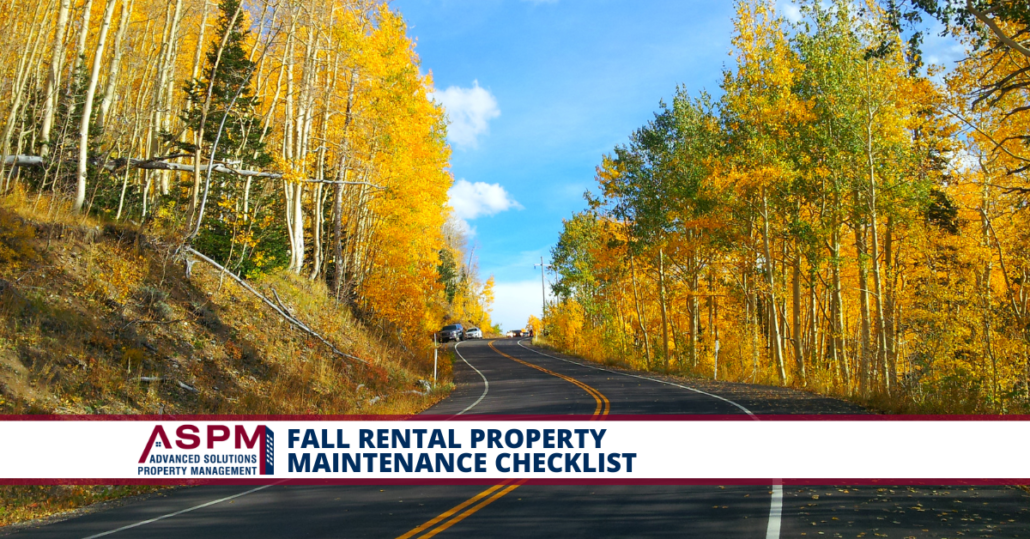57 Ways To Prepare Your Salt Lake Rental Property for Winter: A Landlord’s Checklist
Utah has been in the midst of a heat wave recently, but with temperatures about to change, it’s soon going to really feel like fall. That means it’s the ideal time to start preparing your rental property for colder weather. Here are 57 things you can do to get your investment home ready for winter.
If this seems overwhelming, reach out to us to see why ASPM is a top rated rental management company in Salt Lake City.
Exterior Maintenance
1. Inspect the roof for damaged or missing shingles: Regular inspections help prevent leaks and damage from winter storms.
2. Clean gutters and downspouts: Clearing debris ensures proper drainage and prevents ice dams.
3. Trim tree branches away from the roof and power lines: Trimming reduces the risk of branches breaking and causing damage during winter storms.
4. Check for cracks in exterior walls and seal them: Sealing cracks prevents cold air and moisture from entering the home.
5. Add exterior wall insulation if needed: Improved insulation enhances energy efficiency and tenant comfort during winter.
6. Inspect and repair window and door frames: Ensuring frames are intact prevents drafts and heat loss.
7. Caulk around windows and doors: Proper caulking minimizes air leaks, improving energy efficiency.
8. Install storm windows and doors: These provide an additional barrier against cold winds and snow.
9. Drain and store outdoor hoses: This prevents freezing and cracking during cold weather.
10. Shut off outdoor water valves and insulate spigots: Protecting plumbing from freezing temperatures reduces the risk of burst pipes.
11. Drain sprinkler systems and outdoor fountains: Emptying these systems prevents freeze damage.
12. Clean and cover outdoor furniture: Protecting furniture extends its lifespan against harsh weather conditions.
13. Inspect chimney and clean if necessary: A clean chimney ensures safe fireplace operation during winter use.
14. Check exterior paint and touch up as needed: Maintaining paint protects surfaces from moisture damage.
15. Secure loose siding or trim: Repairing loose sections prevents further damage from wind or snow.
Yard and Landscaping
16. Trim the shrubs: Pruning helps prevent damage from heavy snow accumulation on branches.
17. Remove dead plants and debris from flower beds: Cleaning up encourages healthy soil conditions for spring growth.
18. Aerate and fertilize the lawn: This prepares the lawn for healthy growth when spring arrives.
19. Mulch garden beds for insulation: Mulching protects plant roots from extreme cold temperatures.
20. Wrap delicate plants and shrubs: Insulating vulnerable plants helps them survive harsh winter conditions.
21. Store outdoor planters: Proper storage protects planters from freezing temperatures.
22. Clean and store lawn equipment: Regular maintenance ensures equipment is ready for use in spring.
23. Prepare snow removal equipment: Ensuring shovels, salt, or snow blowers are in good condition allows for efficient snow management.
Plumbing and Pipes
24. Insulate exposed pipes: Insulation prevents freezing, reducing the risk of costly repairs due to bursts.
25. Check for leaks and repair as needed: Addressing leaks early helps prevent water damage during winter months.
26. Drain water heater to remove sediment: Regular maintenance improves efficiency, ensuring hot water availability when needed most.
27. Insulate hot water pipes: Insulating these pipes reduces heat loss, saving energy costs.
HVAC System
28. Schedule professional HVAC inspection and maintenance: Regular servicing keeps heating systems running efficiently through the cold months.
29. Replace furnace filters: Clean filters improve air quality while enhancing system efficiency.
30. Clean air ducts: Clearing ducts promotes better airflow, improving heating distribution throughout the property.
31. Test thermostat for accuracy: Ensuring accurate readings helps maintain consistent indoor temperatures.
Energy Efficiency
32. Add attic insulation if needed: Proper insulation minimizes heat loss through the roof, reducing heating bills significantly.
33. Seal air leaks around windows and doors: Addressing leaks improves energy efficiency by preventing drafts.
34. Install programmable thermostats: These devices allow tenants to manage heating schedules efficiently based on their routines.
35. Reverse ceiling fan direction: Running fans clockwise pushes warm air down, enhancing heating effectiveness without additional energy use.
36. Install insulating curtains or blinds: These window treatments help retain heat indoors while adding an aesthetic touch.
Safety Measures
37. Test smoke and carbon monoxide detectors: Regular checks ensure these devices function properly, protecting tenants from hazards.
38. Replace batteries in detectors: Fresh batteries guarantee continuous protection against fire or gas leaks throughout winter.
39. Check fire extinguishers: Ensure extinguishers are accessible, charged, and ready for emergencies that may arise in colder months.
40. Clear space around furnace: Maintaining clear areas around heaters prevents fire hazards while ensuring efficient operation.
41. Inspect electrical outlets and cords: Check for signs of wear or damage to prevent electrical fires during increased usage.
Interior Maintenance
42. Clean and inspect fireplace: Ensuring fireplaces are clean promotes safe usage during cozy winter evenings with tenants.
43. Check for drafts and add weatherstripping: Weatherstripping reduces drafts effectively while enhancing comfort levels indoors.
44. Inspect basement for moisture issues: Addressing moisture problems now prevents mold growth that can affect tenant health later on.
45. Clean dryer vents: Regular cleaning prevents lint buildup that poses fire risks associated with dryer usage during winter laundry days.
46. Lubricate door hinges and locks: Ensuring smooth operation of doors helps maintain security while preventing wear over time.
Tenant Communication
47. Provide winter maintenance instructions to tenants: Clear guidelines help tenants understand their responsibilities in maintaining the property during winter months.
48. Remind tenants about maintaining minimum heat levels: Encouraging tenants to keep their homes heated prevents frozen pipes that could lead to significant damage.
49. Inform tenants about snow removal responsibilities: Clarifying who manages snow removal helps avoid misunderstandings during heavy snowfall periods.
50. Provide emergency contact information: Ensuring tenants have access to emergency contacts fosters a sense of security during adverse weather events.
Emergency Preparedness
51. Create an emergency winter kit: Stocking essentials prepares everyone for unexpected situations during storms or power outages.
52. Stock up on ice melt and sand: Having these materials on hand facilitates safe walkways around the property during icy conditions.
53. Have a backup power source ready: Generators or battery packs provide peace of mind in case of power outages caused by severe weather conditions.
54. Know how to shut off water main in case of pipe burst: Familiarity with this process allows for quick action to minimize damage if a pipe freezes or bursts.
Professional Services
55. Arrange for gutter cleaning service: Hiring professionals ensures gutters remain clear of debris throughout winter months, preventing ice dams that can cause extensive damage later on.
56. Set up snow removal service if applicable: Having a reliable service ready ensures safe access around the property for tenants during heavy snowfall periods.
57. Schedule professional energy audit: An audit identifies areas where energy efficiency can be improved, benefiting both costs and tenant comfort.
We have seasonal maintenance checklists below:











